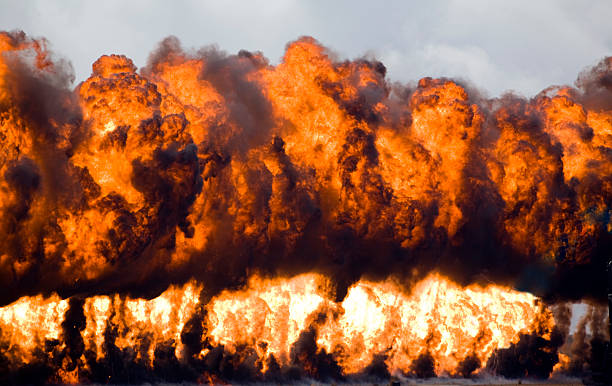Napalm is a highly incendiary weapon known for its devastating and destructive capabilities. It is a type of jellied gasoline developed during World War II and has since become infamous for its use in military conflicts. Napalm is particularly notorious for its ability to create intense and long-lasting fires, causing widespread destruction and significant harm to both combatants and civilians. This article will provide a glimpse into how to make homemade Napalm.
Table of contents
How to Make Homemade Napalm
There are different types of modern Napalm, like Napalm-B, a newer kind. Some napalms are made with hard-to-find ingredients like naphthenic acid and palmitic acid, which is why they’re called that way. But people can also make their own Napalm pretty easily:
- Get a big container and fill it halfway with gasoline (diesel is even better).
- Break up a Styrofoam (that white foam stuff) plate into small pieces.
- Put those pieces into the gasoline and mix it all.
- The gasoline will melt the Styrofoam into a gooey substance.
- Pour out the extra gasoline, and this sticky, white stuff will be left.
- This white stuff is like “napalm.” When you light it, it will burn for a few minutes. Add engine oil to the mixture if you want it to burn slower.
How Napalm is used
Napalm has a notorious history of use in warfare, primarily as a destructive incendiary weapon. Here’s how Napalm has been used:
- Burning Enemy Positions: Napalm is infamous for its ability to start intense fires. It has been used to attack enemy positions, including bunkers, trenches, and fortified areas. When Napalm is dropped or launched, it spreads over a wide area and ignites upon impact, engulfing the target in flames and causing extensive damage.
- Anti-Personnel Weapon: Napalm has been employed as an anti-personnel weapon, causing horrific injuries and fatalities. When used against troops in the open, it can create a terrifying and deadly fire barrier, making it difficult for soldiers to escape.
- Psychological Warfare: The devastating and terrifying nature of napalm strikes can psychologically impact enemy combatants and civilians. The fear of napalm attacks can disrupt enemy morale and lead to surrender or retreat.
- Area Denial: Napalm has been used to deny access to certain areas, such as forests or jungles, by setting them ablaze. This tactic impedes enemy movement and destroys resources, making it harder for the opposing force to sustain itself.
- Counter-Insurgency: Napalm has been employed in counter-insurgency campaigns to flush out insurgents hiding in dense vegetation or urban areas. Its ability to create widespread fires can help root out hidden adversaries.
- Urban Warfare: In urban warfare scenarios, Napalm has been used to clear buildings and structures of enemy combatants. Its intense heat and destructive power can effectively reduce fortified positions to rubble.
- Harbor Blockades: Napalm has been used to block enemy ports and harbors by creating massive fires on the water, rendering them impassable and disrupting enemy logistics.
It’s important to note that using Napalm has raised significant ethical and humanitarian concerns due to its indiscriminate nature and the severe suffering it inflicts on military personnel and civilian populations. As a result, there have been international efforts to restrict or ban the use of napalm-like incendiary weapons in warfare, such as the Convention on Certain Conventional Weapons and the Protocol III on Incendiary Weapons.
Frequently Asked Questions
Napalm is a highly incendiary weapon consisting of a mixture of gasoline, a thickening agent, and other chemicals. It is designed to create intense and long-lasting fires when ignited.
Napalm is primarily used in warfare to attack enemy positions, destroy structures, and disrupt enemy movements. It is known for its ability to cause widespread fires and inflict significant damage.
Due to humanitarian concerns, napalm-like incendiary weapons have been restricted or banned in many countries. However, some nations may still possess and deploy similar incendiary weapons under certain circumstances.
Napalm is highly indiscriminate, causing severe burns and suffering to combatants and civilians. Its use in populated areas can lead to significant harm and has raised ethical and legal questions about its use in warfare.
International agreements like the Convention on Certain Conventional Weapons and Protocol III on Incendiary Weapons seek to regulate incendiary weapons, including Napalm, to minimize their humanitarian impact and prevent their use inappropriately.
Conclusion
Napalm, with its devastating and indiscriminate incendiary power, has left a lasting mark on the history of warfare. Its destructive capabilities have led to international efforts to restrict its use, highlighting the ethical and humanitarian concerns associated with this weapon.
References
- geekslop.com: How to make homemade Napalm
- quora.com: Homemade Napalm






